Content
Under natural conditions, astilbe grows in a monsoon climate, so it is hardy to adverse conditions. The plant feels comfortable in cold regions. Comprehensive preparation of Astilba for winter will help minimize the influence of unfavorable weather and provide conditions for normal development for the next year.
Features of wintering astilba in the open field
The plant is highly frost-resistant. Because of this, many growers make a serious mistake by not taking any action. In fact, you need comprehensive care for astilba in the fall in preparation for winter.
The main reason this procedure is required is that the plant is not intended to be grown in flower beds and gardens. Astilba is a perennial found in mountainous regions at an altitude of up to 5 thousand meters. The shrub is resistant to these conditions, but may suffer from factors to which it has not previously been adapted.
Preparation for winter includes a set of activities. It is necessary to consider the main stages of this procedure.
What to do with astilba in autumn
In order for a young plant to endure the winter well, peduncles are removed from it as soon as they begin to form. Then the nutrients will be spent not on seed formation, but on strengthening the root system. Thanks to this, young astilba will root better before the onset of cold weather.
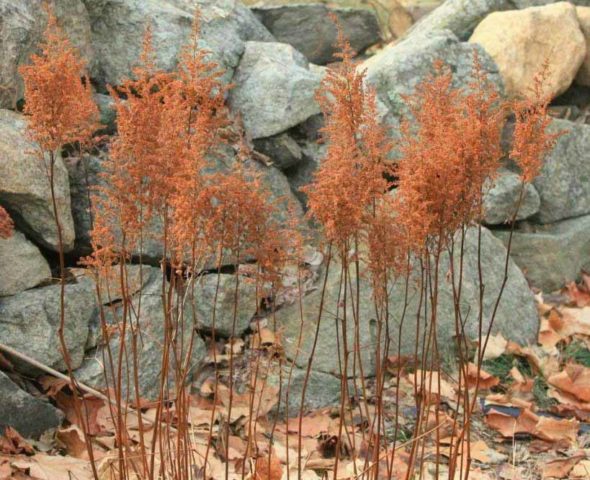
Astilba is very hardy and frost-resistant
In September and early October, before the onset of the first frost, you need to maintain an abundant watering regime for the bush. Astilba does not tolerate drought. If it is grown in areas well-lit by the sun, then you need to provide it with water daily, until the moment of regular precipitation.
How to care for astilba in autumn
Leaving comes down to performing several simple procedures. But they need to be carried out in a timely manner, otherwise the bush will not have time to adapt to new conditions.
Do I need to cut astilba for the winter
Usually, the buds are cut immediately after flowering. But they can be saved so as not to spoil the appearance of the flower bed. In the fall, with the onset of the first frost, the entire above-ground part of the bush is removed. The optimal time is the first half of November.

In the first year of life after planting, the plant needs special care.
Plant pruning method:
Cleaning in the flower garden
This procedure is required if astilbe is grown next to other plants. Along with trimming, you need to remove the remnants of other colors. It is also necessary to remove all debris: fallen leaves, branches, weeds.

When the shrub grows, it can drive out all the weeds.
Loosening and mulching of the soil
Astilba is demanding on the composition of the soil. Lack of sufficient nutrients in the soil can be detrimental to the plant. Therefore, when preparing astilba for winter in the Moscow region or other regions, you need to pay attention to the soil.
Soil for astilba must pass liquid well in order to prevent stagnation. For this, loosening is carried out.
The soil must be loosened to a depth of at least 8 cm. When preparing bushes over 5 years old, care must be taken. Their roots grow strongly and can make their way out. They can be accidentally damaged during the loosening process. After that, mulching is carried out. This preparation helps to improve the properties of the soil.
Recommended organic mulches:
- leaf humus;
- dry manure or droppings;
- straw;
- garden compost;
- pine needles;
- peat;
- sawdust, shavings.

Cut bushes need to be covered with a layer of mulch: coniferous litter, peat, compost
The layer of mulch for astilba should be 2-3 cm. Such preparation will keep the liquid in the soil, prevent freezing, erosion and make the soil loose.
How to fertilize astilba in the fall
In preparation for winter, additional feeding is necessary. It is held twice. The first time astilba is fertilized after flowering. They use formulations containing phosphorus and potassium, which quickly absorb the roots and enrich the plant with valuable substances. Each bush requires 1-2 tablespoons, no more. Also in the fall, you can fertilize astilbe with ash.
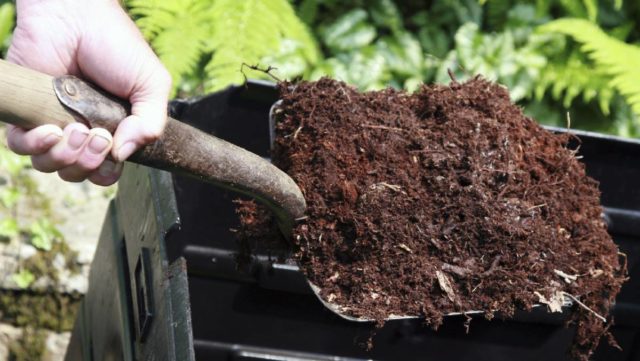
In the fall, you need to apply fertilizers rich in potassium and phosphorus.
Organic feed is applied before the onset of frost. They are needed to provide the bush with nutrients in early spring. Organic residues are subject to long-term decomposition, therefore, when applied in late autumn, they will fertilize the bush only after a few months. Moreover, at low temperatures, this process slows down.
How to prepare astilba for winter
The main procedures are performed in the fall. The final stages of preparation are performed in early to mid-November. After cutting the stems from the bush, it is recommended to spud it to a height of 4-5 cm. This is necessary so that young buds are not exposed and are not exposed to frost. A layer of organic mulch is also added on top.
In the suburbs, for preparation, it is enough to thoroughly loosen and fertilize the soil. However, this rule only applies if a not too cold winter is forecasted. Astilbe is pruned, fertilized, and the soil is mulched with spruce branches, straw or other organic matter that allows air to pass through well.
In the Urals and Siberia, astilbe winter sheltered. This is necessary to protect them from the harmful effects of the wind. The soil in these regions freezes by 80-100 cm. Therefore, mulching the soil alone is not enough to prepare Astilba for winter in Siberia.
Other stages of preparation:
- Gradually reduce the frequency of watering (starting at the end of October).
- Treatment with fungicides against diseases and pests.
- Removal of weakened shoots.
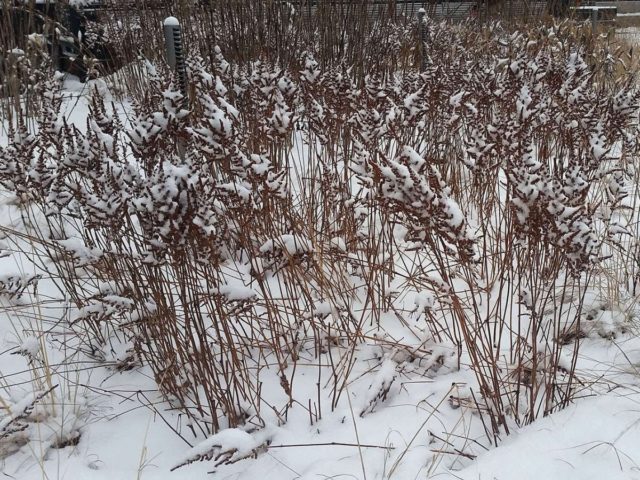
So that the root system does not suffer from frost, you need to cover the plant with spunbond or spruce branches
It should be borne in mind that astilbes need careful preparation in the first year of life, as well as bushes that have been depleted in dry summer. Before the onset of cold weather, the plant must be completely restored, otherwise it may die.
When and how to shelter astilba for the winter
In some regions of Russia, the plant needs reliable protection from frost. To do this, you need to cover the astilbe for the winter.
Main steps:
- Stick 4 wooden blocks into the ground at a distance of 15-20 cm from the bush on each side.
- Connect them with thin boards.
- Pour dry foliage inside the frame.
- Cover the top with porous material and thick plastic wrap.
- Press the material with bricks or stones, sprinkle it with earth so as not to be carried away by the wind.
Before covering astilba for the winter, you need to make sure that the selected plastic wrap is breathable.Otherwise, the flow of oxygen to the soil will be disrupted, which can lead to the death of the bush.
In outskirts of Moscow
It is not necessary to cover astilbe in central Russia. Such preparation is needed if a cold winter is expected.
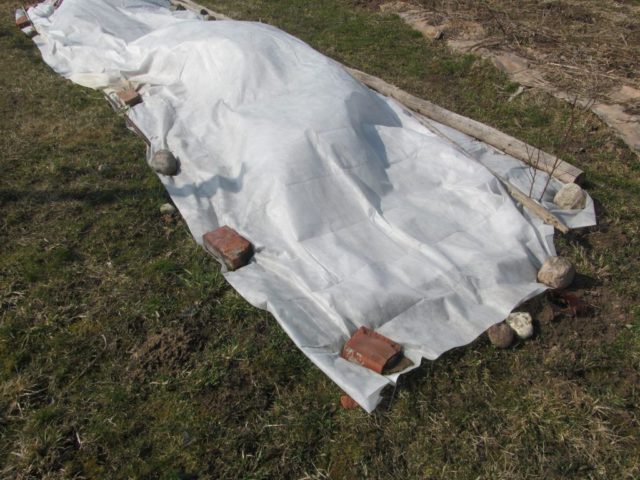
It is advisable to cover the plant with a material that allows air to pass through and does not create a greenhouse effect.
In early November, soil mulching, hilling and fertilization are carried out. You can cover the plant without using a wooden frame using foliage, needles and a breathable film.
In the Urals
Due to the harsh climate, the plant must be protected from the cold. Moreover, the preparation of astilba for winter in the Urals must be carried out earlier than in the Moscow region.
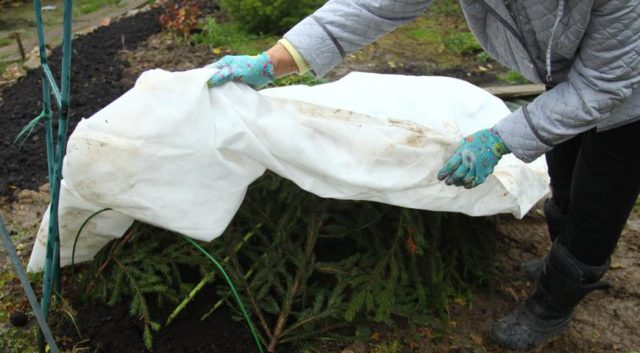
Roots closer to the surface of the earth can freeze, so they need to be covered with coniferous spruce branches.
The shelter is carried out at the onset of a persistent drop in temperature. This usually happens in mid to late October. At this point, the bush should already be pruned and fertilized.
In Siberia
Astilba normally tolerates temperatures down to -15 degrees. However, in winter in Siberia, the temperature often drops below this mark. Therefore, a frame shelter is required.
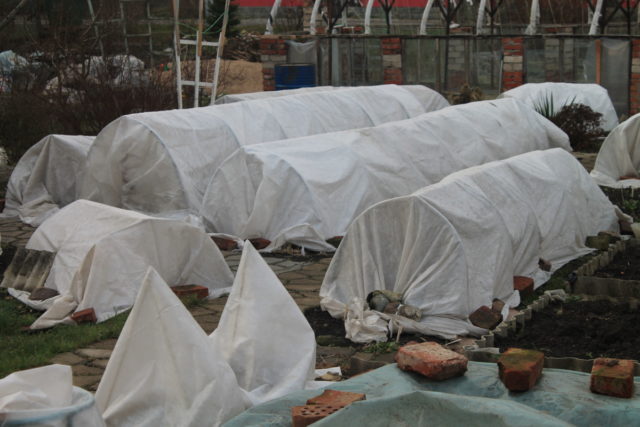
The root system of astilba is able to withstand temperatures of -25 degrees
In this case, it is necessary to cover the trimmed bush with a layer of foliage, straw or sawdust to maintain the temperature. This is especially important if the plant has roots close to the surface.
Professional advice
The main task of the shelter for the winter is to protect not from frost, but from sudden changes in temperature. That is why the plant is covered with dry plant materials: foliage, sawdust, straw. In this case, an airtight film is required to supply the sheltered astilba with oxygen and protect it from pests.
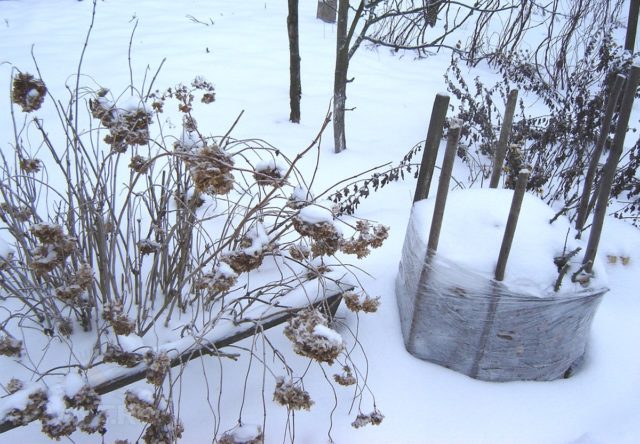
If you do not cover astilba for the winter, then the next year the plant will grow worse and the flowering will be weak
If snow falls, it is recommended to throw it over the film. This will create an additional protective layer for the covered astilbe. So that the snow does not spread, you can put branches of spruce branches on it.
Conclusion
Preparing astilba for winter is a set of measures necessary to protect the plant from the influence of unfavorable climatic conditions. Most procedures are carried out in mid and late autumn, before the onset of a persistent drop in temperature. Provided for pruning, plant feeding, soil fertilization and shelter for the winter.








